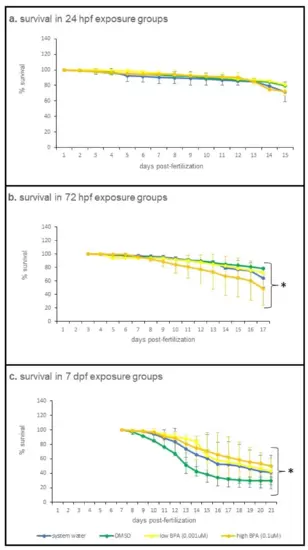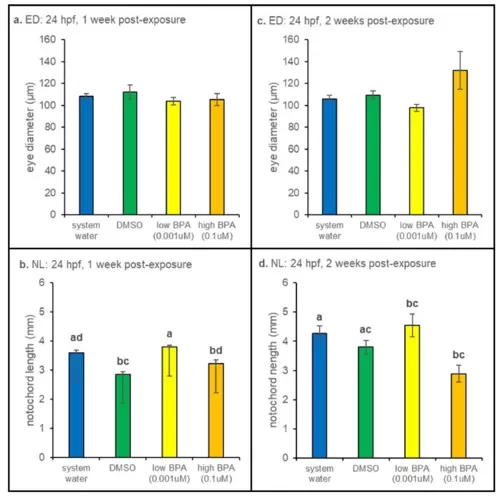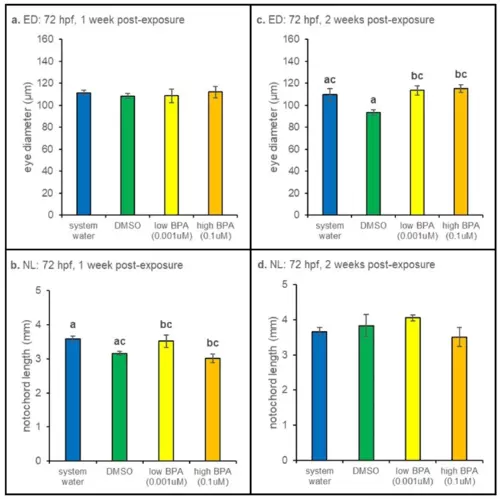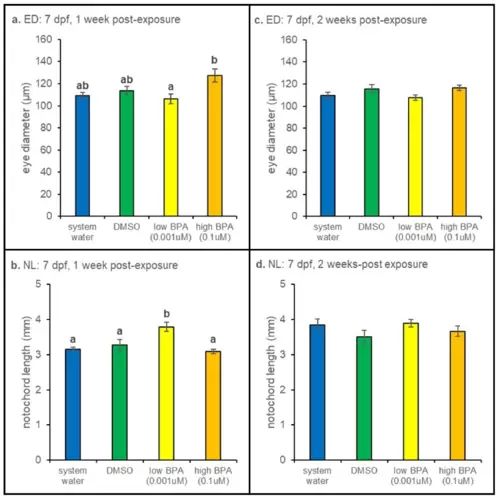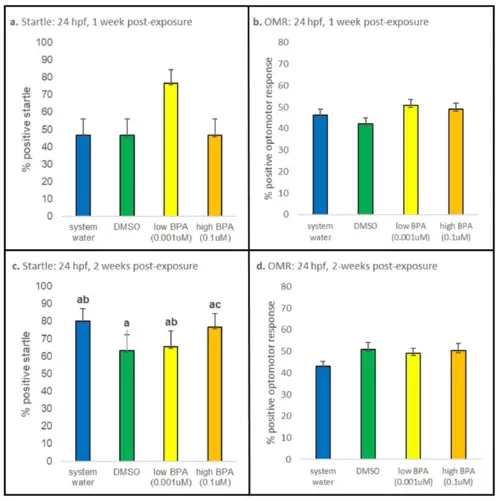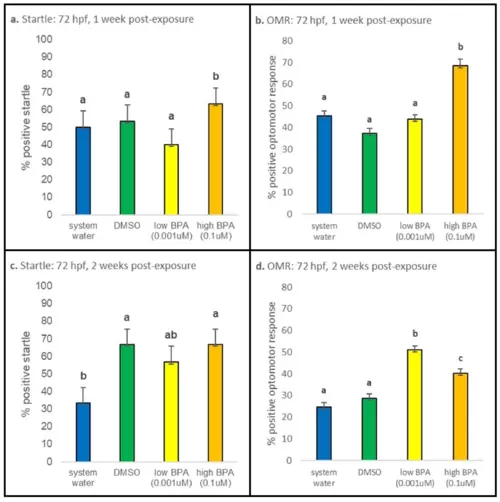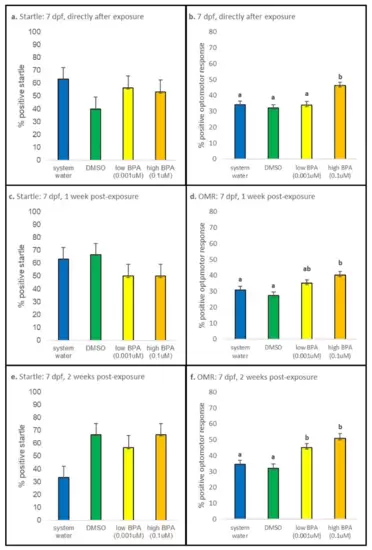- Title
-
Zebrafish Optomotor Response and Morphology Are Altered by Transient, Developmental Exposure to Bisphenol-A
- Authors
- Crowley-Perry, M., Barberio, A.J., Zeino, J., Winston, E.R., Connaughton, V.P.
- Source
- Full text @ J Dev Biol
|
Survival trends across all exposure ages and recovery sampling points. Survival was analyzed using a general linearized model, with treatment as the fixed factor and day as the co-variate. Values are reported as mean percent daily survival ± SD for each treatment group. (a) Overall daily survival of larvae exposed at 24 hpf was unaffected by treatment (p = 0.238). For 24 hpf exposures, initial populations were as follows: system water = 341; DMSO = 250; low BPA = 355; high BPA = 250. (b) Overall daily survival of larvae exposed at 72 hpf was significantly impacted by treatment (p < 0.001). For 72 hpf exposures, initial populations were system water = 293; DMSO = 250; low BPA = 298; high BPA = 250. (c) Overall daily survival of larvae exposed at 7 dpf was significantly impacted by treatment (p = 0.005). For the 7 dpf exposure groups, survival between treatment groups was assessed at 1 week and 2 week postexposure using one-way ANOVA, followed by a Tukey post hoc test; survival at these points was not significantly different: p = 0.191 at 1 week (14 dpf), and p = 0.811 at 2 weeks (21 dpf). For 7 dpf exposures, initial populations were system water = 231; DMSO = 221; low BPA = 293; high BPA = 226. Asterisks denote significant differences. |
|
Twenty-four hours postfertilization anatomical measurements. (a) Larvae exposed at 24 hpf did not display any differences in eye diameter after 1 week of recovery. (b) However, larvae in the low BPA treatment group were significantly larger than vehicle controls and larvae exposed to high BPA (p < 0.001) at 1 week post-exposure. (c) After 2 weeks, larvae exposed at 24 hpf still displayed no differences in eye diameter, despite the larger values in the high BPA treatment group. (d) Larvae exposed to high BPA had the smallest mean length at 2 weeks post-exposure. Significant differences were noted across treatments (p = 0.006), however these values were not different from the vehicle control. At each recovery point n = 5 for all treatment groups. Differences in notochord length and eye diameter across treatment were assessed using a one-way ANOVA followed by a Tukey post hoc test at each exposure age. Eye diameter measurements were normalized to notochord lengths prior to statistical analysis. All values are reported as mean ± SE. Different letters denote significance. PHENOTYPE:
|
|
Seventy-two hours postfertilization anatomical measurements. (a) Larvae exposed at 72 hpf displayed no significant differences in eye diameter after 1 week of recovery. (b) Though significant differences in length were observed (p = 0.014), BPA- and vehicle-treated animals were not different. (c) Eye diameter was significantly increased in both low and high BPA exposure groups at the 2 week time point (p = 0.006). (d) No significant differences in notochord length were evident after 2 weeks of recovery. At each recovery point n = 5 for all treatment groups. Differences in notochord length and eye diameter across treatment were assessed using a one-way ANOVA followed by a Tukey post hoc test at each exposure age. Eye diameter measurements were normalized to notochord lengths prior to statistical analysis. All values are reported as mean ± SE. Different letters denote significance. PHENOTYPE:
|
|
Seven days postfertilization anatomical measurements. (a) Compared to controls, eye diameter was not increased in either BPA group after 1 week of recovery, though the high BPA exposure group had significantly larger eyes than the low BPA exposed larvae (p = 0.022). (b) After 1 week of recovery, notochord length was significantly increased larvae exposed to low BPA (p < 0.001). No significant differences were noted after 2 weeks of recovery for either (c) eye diameter or (d) notochord length. At each recovery point n = 5 for all treatment groups except for DMSO, in which n = 4. Differences in notochord length and eye diameter across treatment were assessed using a one-way ANOVA followed by a Tukey post hoc test at each exposure age. Eye diameter measurements were normalized to notochord lengths prior to statistical analysis. All values are reported as mean ± SE. Different letters denote significance. PHENOTYPE:
|
|
Twenty-four hours postfertilization behavioral results. (a) After 1 week of washout, larvae exposed at 24 hpf did not display statistically different startle responses. (b) No differences were noted in OMRs displayed by after 1 week of recovery. (c) At 2 weeks post-exposure, larvae exposed to high BPA displayed increased startle responses compared to larvae exposed to low BPA only (p = 0.001). (d) No differences in OMRs were observed in larvae exposed at 24 hpf at the 2 week time point. At each recovery point n = 30 for all treatment groups. Startle responses were analyzed using a one-way ANOVA performed separately for each age and treatment group; if significance was noted, a Tukey post hoc test was performed to identify differences. OMR was analyzed using a one-way ANOVA, followed by a post hoc multiple comparison (with a Bonferroni correction). All values are reported as mean ± SE. Different letters denote significance. PHENOTYPE:
|
|
Seventy-two hours postfertilization behavioral results. (a) After 1 week of recovery, larvae exposed to the high concentration of BPA at 72 hpf displayed statistically increased startle responses relative to all other treatment groups (p < 0.001). (b) There was also a significant increase in positive OMRs (p < 0.001) in the high BPA group. (c) At the 2 week recovery time, larvae exposed to high BPA displayed significantly increased startle responses compared to low BPA exposed larvae (p = 0.003), though neither response was different from the vehicle control. (d) The percentage of larvae displaying a positive OMR was significantly increased in both the low BPA (p < 0.001) and high BPA (p = 0.001) treatment groups, with the greatest response observed in larvae exposed to low BPA. At each recovery point n = 30 for all treatment groups. Startle responses were analyzed using a one-way ANOVA performed separately for each age and treatment group; if significance was noted, a Tukey post hoc test was performed to identify differences. OMR was analyzed using a one-way ANOVA, followed by a post hoc multiple comparison (with a Bonferroni correction). All values are reported as mean ± SE. Different letters denote significance. PHENOTYPE:
|
|
Seven days postfertilization behavioral results. No differences in startle responses were observed in larvae assessed a. immediately, c. after 1 week of recovery, or e. after 2 weeks of recovery when exposure occurred at 7 dpf. In contrast, b. larvae exposed to high BPA displayed a significant increase in the percentage of fish displaying a positive OMR when assessed immediately after exposure (p < 0.001). Increased numbers of larvae displaying a positive OMR were also observed d. after 1 week of recovery (p = 0.020) and f. after 2 weeks of recovery in larvae exposed to both low (p < 0.036) and high (p < 0.001) BPA. At each recovery point n = 30 for all treatment groups. Startle responses were analyzed using a one-way ANOVA performed separately for each age and treatment group; if significance was noted, a Tukey post hoc test was performed to identify differences. OMR was analyzed using a one-way ANOVA, followed by a post hoc multiple comparison (with a Bonferroni correction). All values are reported as mean ± SE. Different letters denote significance. PHENOTYPE:
|

